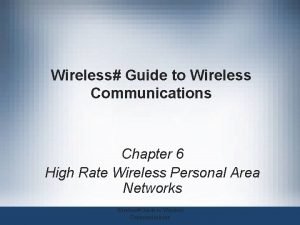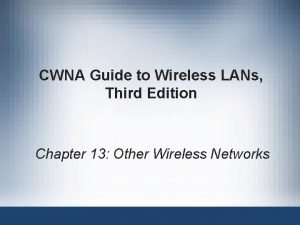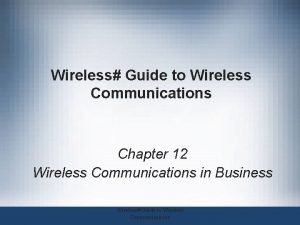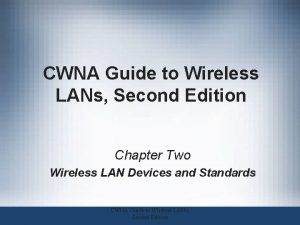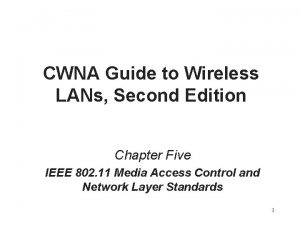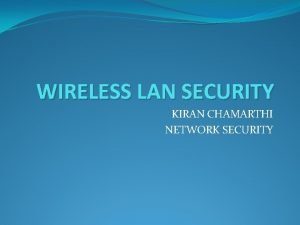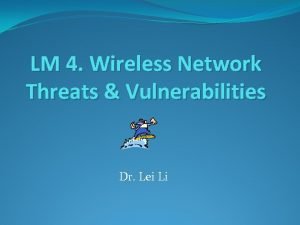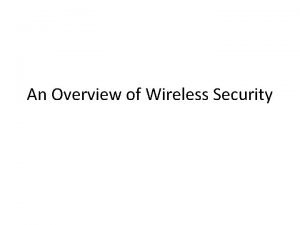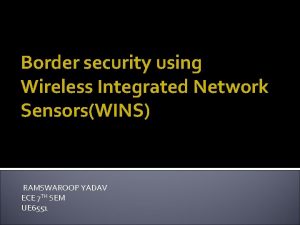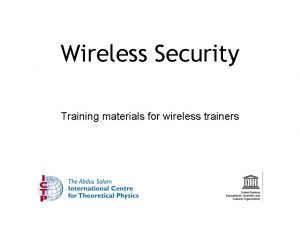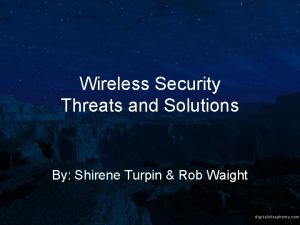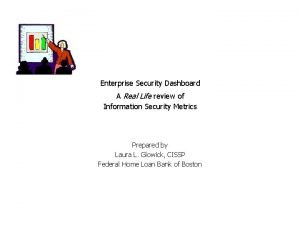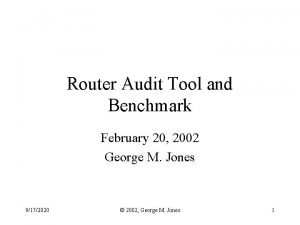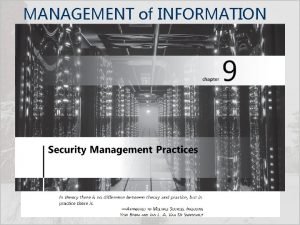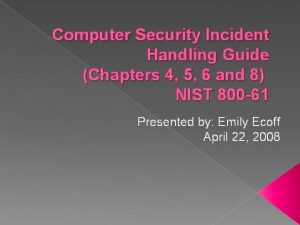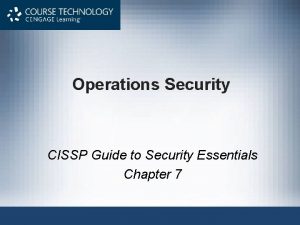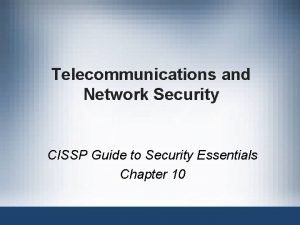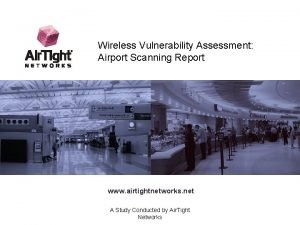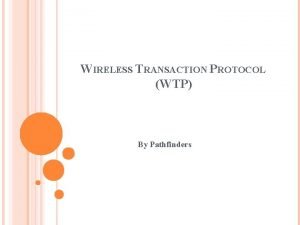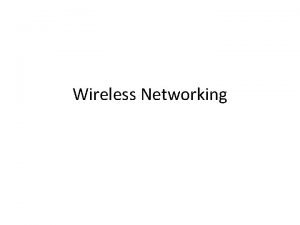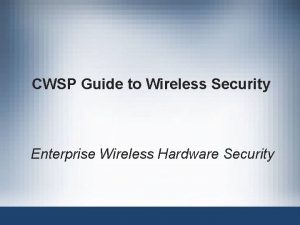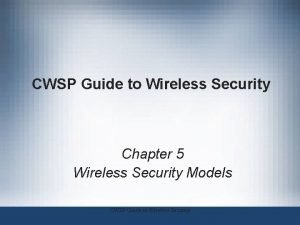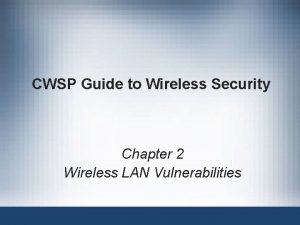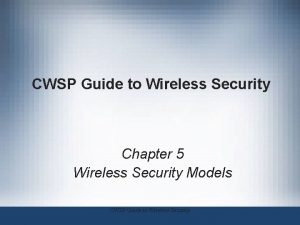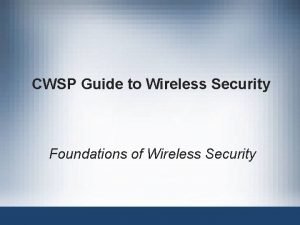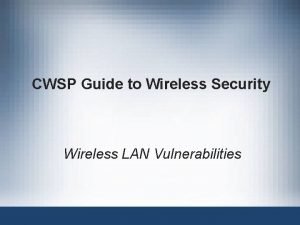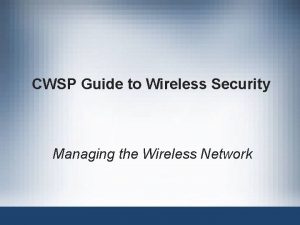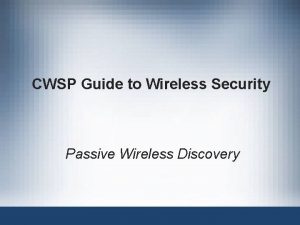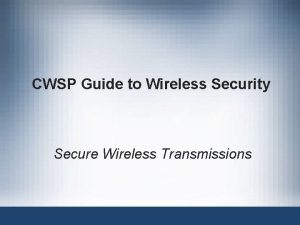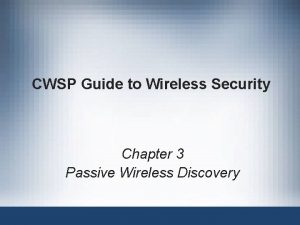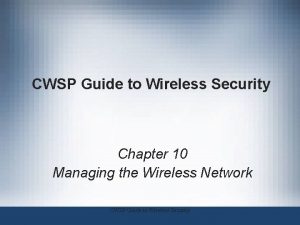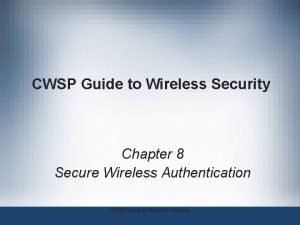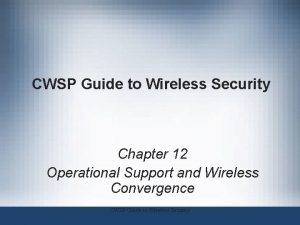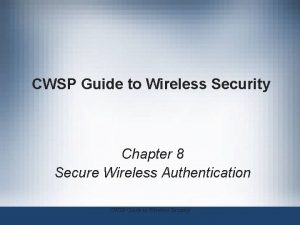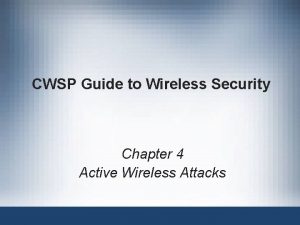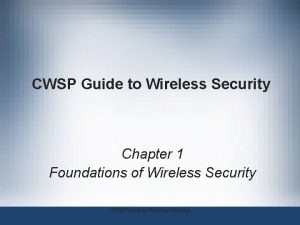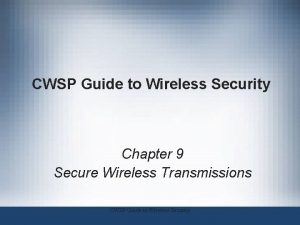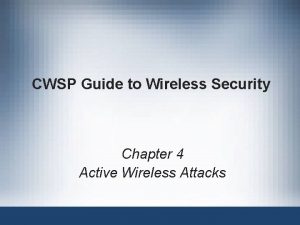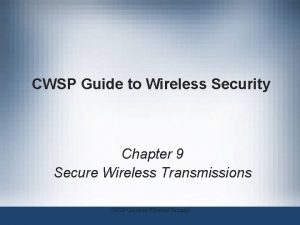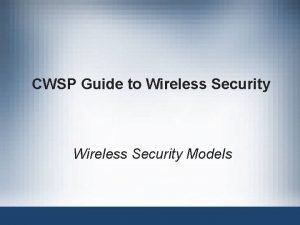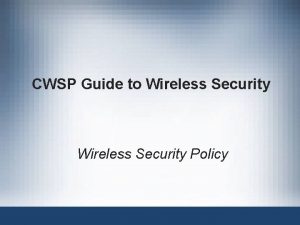CWSP Guide to Wireless Security Chapter 6 Enterprise

















































- Slides: 49

CWSP Guide to Wireless Security Chapter 6 Enterprise Wireless Hardware Security CWSP Guide to Wireless Security

Objectives • List and describe the functions of the different types of wireless LAN hardware used in an enterprise • Tell how access control and protocol filtering can protect a WLAN • Describe the functions of Quality of Service, handoffs, and power features of wireless networking hardware CWSP Guide to Wireless Security 2

Enterprise WLAN Hardware • Wireless hardware – – – Access points Remote wireless bridges Wireless routers Wireless gateways Wireless switches Wireless mesh routers CWSP Guide to Wireless Security 3

Access Point • AP parts – An antenna and a radio transmitter/receiver to send and receive signals – An RJ-45 wired network interface that allows it to connect by cable to a standard wired network – Special bridging software to interface wireless devices to other devices • Basic functions – Acts as the base station for the wireless network – Acts as a bridge between wireless and wired network CWSP Guide to Wireless Security 4

Access Point (continued) • Range of an access point depends on: – Type of wireless network that is supported – Walls, doors, and other solid objects can reduce the distance the signal may travel • Number of wireless clients supported varies – Theoretical: 100 clients – For light traffic: 50 clients – For heavy traffic: 20 clients CWSP Guide to Wireless Security 5

Remote Wireless Bridge • Bridge – Connects two network segments together – Segments can use different types of physical media – Software for transmitting and receiving signals • Remote wireless bridge – Wireless device designed to connect two or more wired or wireless networks – Transmits at higher power than APs – Uses a highly directional or semi-directional antenna CWSP Guide to Wireless Security 6

Remote Wireless Bridge (continued) • Highly directional antennas – Usually concave, dish-shaped devices used for long distance, point-to-point wireless links • Semi-directional antenna – Focuses the energy in one direction – Does not have the high power level of a highly directional antenna – Primarily used for short- and medium-range remote wireless bridge networks CWSP Guide to Wireless Security 7

Remote Wireless Bridge (continued) CWSP Guide to Wireless Security 8

Remote Wireless Bridge (continued) • Delay spread – Minimizes the spread of the signal so that it can reach farther distances • Remote wireless bridges support two types of connections – Point-to-point connections – Point-to-multipoint connections CWSP Guide to Wireless Security 9

Remote Wireless Bridge (continued) CWSP Guide to Wireless Security 10

Remote Wireless Bridge (continued) CWSP Guide to Wireless Security 11

Remote Wireless Bridge (continued) • Remote wireless bridge modes – Access point mode • Standard AP – Root mode • Acts as a root bridge and can communicate only with other non-root bridges – Non-root mode • Can transmit only to a root bridge – Repeater mode • Extends the distance between LAN segments CWSP Guide to Wireless Security 12

Remote Wireless Bridge (continued) CWSP Guide to Wireless Security 13

Remote Wireless Bridge (continued) CWSP Guide to Wireless Security 14

Remote Wireless Bridge (continued) • Remote wireless bridges – Cost-effective alternative to expensive leased wired options for connecting remote buildings – Distance can be up to 29 kilometers (18 miles) transmitting at 11 Mbps • Or up to 40 kilometers (25 miles) transmitting at 2 Mbps CWSP Guide to Wireless Security 15

Wireless Router • Router – Transfers packets between networks – Selects the best link (route) to send packets • Wireless router – Combines an access point with a router – Typically with multiple ports • Advantages – Connects multiple networks – Improves network performance – Shares single IP address CWSP Guide to Wireless Security 16

Wireless Router (continued) CWSP Guide to Wireless Security 17

Wireless Router (continued) CWSP Guide to Wireless Security 18

Wireless Gateway • Gateway – Acts as an entrance to another network • Wireless gateway – Combines an access point, router, network address translation, and other networking features • Enterprise wireless gateway functions – – – Authentication Encryption Intrusion detection and malicious program protection Bandwidth management Centralized network management CWSP Guide to Wireless Security 19

Wireless Switch • Switch – Joins multiple computers within one LAN – Contains more “intelligence” than a hub • Types of switches – Unmanaged switch • Provides no management capabilities of the switch – Managed switch • Provides all of the features of an unmanaged switch along with enhanced management features • Supports both control and monitoring of the network CWSP Guide to Wireless Security 20

Wireless Switch (continued) • One of the challenges of a wireless LAN in an enterprise setting – Integrates management of wired and wireless networks • Wireless switch – Often a rack-mounted unit – Performs user authentication and encryption • Thin access point – Simplified radios with a media converter for the wired network CWSP Guide to Wireless Security 21

Wireless Switch (continued) CWSP Guide to Wireless Security 22

Wireless Switch (continued) • Advantages – Simplified wireless network management – Eliminates handoff procedures • Disadvantages – All thin APs and wireless switches are proprietary – Thin APs do not provide true convergence of the wired and wireless networks • IEEE 802. 1 v protocol – Assists the management of WLAN devices CWSP Guide to Wireless Security 23

Wireless Switch (continued) • IEEE 802. 1 v protocol features – Load balancing – Automatic configuration – Preserves battery life CWSP Guide to Wireless Security 24

Wireless Mesh Routers • Limitations of connecting APs to a router via the wired network – Placement of APs is limited – APs have a limited range • Mesh networks – Solve these limitations – Provide multiple paths through which data can travel – Best example: the Internet • Wireless mesh network – Allows for multiple paths for wireless transmissions CWSP Guide to Wireless Security 25

Wireless Mesh Routers (continued) CWSP Guide to Wireless Security 26

Wireless Mesh Routers (continued) CWSP Guide to Wireless Security 27

Wireless Mesh Routers (continued) • Wireless mesh network types – Ad hoc wireless mesh network • Allows greater distances away from the access point • Each client device can act as a relay station for signals • Advantages – Decentralized network – Can decrease costs – Can also be reliable CWSP Guide to Wireless Security 28

Wireless Mesh Routers (continued) CWSP Guide to Wireless Security 29

Wireless Mesh Routers (continued) • Wireless mesh network types (continued) – Backhaul wireless mesh network • Connects special access points, known as wireless mesh routers – In a mesh configuration • Provides alternative data paths for the “backside” connection to the Internet • Backhaul – Connection from the routers to the Internet • Used extensively in outdoor municipal WLANs • Can be quickly deployed in an emergency CWSP Guide to Wireless Security 30

Wireless Mesh Routers (continued) CWSP Guide to Wireless Security 31

Wireless Mesh Routers (continued) • No standards exist for wireless mesh networks – IEEE 802. 11 s task group is working on standards • Over 70 different wireless mesh routing protocols – Differ in the following features: • Algorithm • Management data versus transmit data • Number of radios CWSP Guide to Wireless Security 32

Hardware Security Features • Features include: – Controlling access to hardware – Protocol filtering CWSP Guide to Wireless Security 33

Controlling Access to Hardware • Access control – Restricts the user to accessing only the resources essential for the user to do his or her job – Limits access to resources based on the users’ identities and their membership in various groups • Mandatory access control (MAC) – Most restrictive model – User is not allowed to give access to another user to use or access anything on the network – All controls are fixed in place and there is no flexibility – Typically used in military environments CWSP Guide to Wireless Security 34

Controlling Access to Hardware (continued) • Role based access control (RBAC) – Administrator assigns permissions to a position (role) • Assign users and other objects to that role • Discretionary access control (DAC) – Least restrictive model – User can adjust the permissions for other users over network devices – Poses risks in that incorrect permissions may be granted or given CWSP Guide to Wireless Security 35

Controlling Access to Hardware (continued) CWSP Guide to Wireless Security 36

Protocol Filtering • Filtering restricts the traffic on a network based on specific criteria • Types of filtering – Address filtering – Data filtering – Protocol filtering • Some access points can be configured to filter unwanted protocols – From either entering or leaving the wireless network • Can only be used in a few specific situations CWSP Guide to Wireless Security 37

Protocol Filtering (continued) CWSP Guide to Wireless Security 38

Other Hardware Features • Features include: – Quality of service – Fast handoff – Power features CWSP Guide to Wireless Security 39

Quality of Service (IEEE 802. 11 e) • IEEE 802. 11 standard was intended to be “fair” – Not appropriate for real-time traffic • Quality of Service (Qo. S) – Capability to prioritize different types of frames • IEEE 802. 11 e task group has two new modes of operation for the 802. 11 MAC layer – Enhanced Distributed Channel Access (EDCA) – Hybrid Coordination Function Controlled Channel Access (HCCA) CWSP Guide to Wireless Security 40

Quality of Service (IEEE 802. 11 e) (continued) • Enhanced Distributed Channel Access (EDCA) – Contention-based – Supports four different “streams” (types) of traffic • • Voice Video Best effort Background – Provides relative Qo. S but cannot guarantee its service CWSP Guide to Wireless Security 41

Quality of Service (IEEE 802. 11 e) (continued) • Hybrid Coordination Function Controlled Channel Access (HCCA) – Based upon polling – Serves as a centralized scheduling mechanism • Wi-Fi Multimedia (WMM) – Wi-Fi Alliance’s own Qo. S specification – Modeled after a wired network Qo. S prioritization scheme – Subset of IEEE 802. 11 e – Defines new Arbitrary Inter-frame Space Number (AIFSN) and contention window values CWSP Guide to Wireless Security 42

Quality of Service (IEEE 802. 11 e) (continued) CWSP Guide to Wireless Security 43

Handoffs • Inter-Access Point Protocol (IAPP) (IEEE 802. 11 F) – 802. 11 standard did not specify how communications were to take place between access points – 802. 11 F specified information that access points need to exchange to support WLAN roaming • Fast Handoff (IEEE 802. 11 r) – Vo. WLAN mobile phones need fast handoff – Allows a wireless client to determine the Qo. S (and security) being used at a different AP • Before making the transition CWSP Guide to Wireless Security 44

Power Features • Dynamic Frequency and Power Control (IEEE 802. 11 h) – 802. 11 h is designed to enable WLAN devices to share the 5 GHz spectrum – Mechanisms • Dynamic frequency selection (DFS) – Switches the WLAN to another channel if necessary • Transmit power control (TPC) – Designed to reduce interference – Reduces radio transmit power used by devices CWSP Guide to Wireless Security 45

Power Features (continued) • Power over Ethernet (IEEE 802. 3 af) – APs are typically mounted high off the ground • To reduce interference from surrounding objects – Electrical power outlets are generally not found in these locations – Power over Ethernet (Po. E) • Delivers direct current (DC) to the AP through the unused wires in a standard UTP Ethernet cable – End-span • Ethernet switch that has embedded Po. E technology CWSP Guide to Wireless Security 46

Power Features (continued) • Power over Ethernet (IEEE 802. 3 af) (continued) – Failover support • Has duplicate equipment alongside the main equipment – Hot standby CWSP Guide to Wireless Security 47

Summary • Wireless hardware – – – Access points Remote wireless bridges Wireless routers Wireless gateways Wireless switches Wireless mesh routers • Access control limits access to resources – Based on the users’ identities and membership CWSP Guide to Wireless Security 48

Summary (continued) • Some access points can be configured to filter unwanted protocols • The capability to prioritize different types of frames is known as Quality of Service • Inter-Access Point Protocol (used in IEEE 802. 11 F) sets standards for handoffs between access points – Fast handoff is based on the IEEE 802. 11 r standard • Power management types – IEEE 802. 11 h standard – Power over Ethernet (IEEE 802. 3 af) CWSP Guide to Wireless Security 49
 Wireless security in cryptography and network security
Wireless security in cryptography and network security Telecommunications the internet and wireless technology
Telecommunications the internet and wireless technology Guide to network security
Guide to network security Security guide to network security fundamentals
Security guide to network security fundamentals Security guide to network security fundamentals
Security guide to network security fundamentals Security private
Security private Guide to wireless communications 4th edition
Guide to wireless communications 4th edition Cwna guide to wireless lans 3rd edition
Cwna guide to wireless lans 3rd edition Guide to wireless communications
Guide to wireless communications Cwna guide to wireless lans
Cwna guide to wireless lans Cwna guide to wireless lans
Cwna guide to wireless lans Wireless network security definition
Wireless network security definition Wireless security threats and vulnerabilities
Wireless security threats and vulnerabilities Wireless transport layer security
Wireless transport layer security 802-11-wireless-security
802-11-wireless-security Wireless integrated network sensors
Wireless integrated network sensors Wireless security training
Wireless security training Wireless security threats
Wireless security threats Putting the enterprise into the enterprise system
Putting the enterprise into the enterprise system Enterprise
Enterprise Sas enterprise guide
Sas enterprise guide E2af
E2af Serve as your guide in managing your enterprise
Serve as your guide in managing your enterprise Enterprise security dashboard
Enterprise security dashboard Enterprise security solutions
Enterprise security solutions Enterprise cabling & security solutions
Enterprise cabling & security solutions Nsa router security configuration guide
Nsa router security configuration guide Nist 800-55
Nist 800-55 Computer security incident handling guide
Computer security incident handling guide Cissp guide to security essentials
Cissp guide to security essentials Cissp guide to security essentials
Cissp guide to security essentials The osi security architecture
The osi security architecture Visa international security model diagram
Visa international security model diagram Electronic mail security in network security
Electronic mail security in network security Cnss security model 27 cells example
Cnss security model 27 cells example Security policy and integrated security in e-commerce
Security policy and integrated security in e-commerce Software security touchpoints
Software security touchpoints Chapter 2 free enterprise in the united states answer key
Chapter 2 free enterprise in the united states answer key Goals of free enterprise
Goals of free enterprise Lesson 3 evaluating economic performance
Lesson 3 evaluating economic performance Monopoly is a menace of free enterprise
Monopoly is a menace of free enterprise Goals of scientific enterprise in psychology
Goals of scientific enterprise in psychology Chapter 7 the business of free enterprise
Chapter 7 the business of free enterprise Managing the business enterprise
Managing the business enterprise Waites sensor technologies
Waites sensor technologies Wireless vulnerability scanner
Wireless vulnerability scanner Explain wireless transaction protocol
Explain wireless transaction protocol Air ionization in wireless power transmission
Air ionization in wireless power transmission Wireless power transmission project report doc
Wireless power transmission project report doc Wireless networks definition
Wireless networks definition






